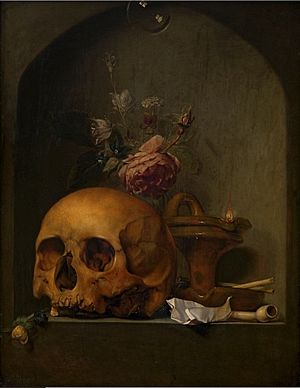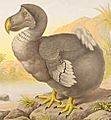Death facts for kids
Death is when a living thing stops being alive. All the body's activities, like thinking and sensing, come to an end. Usually, we know someone has died when their heart stops beating and cannot be started again. Many things can cause this. All living things have a limited time they can live, and eventually, all living things die. When a living thing has died, we say it is dead. About 150,000 people die each day around the world. Most of these deaths are due to getting old. Many cultures have their own traditions and ceremonies to remember and respect those who have died.

Contents
Understanding Death
When a person or animal dies, doctors often try to find out why. This helps us understand diseases and keep others safe. Our bodies can repair themselves, but this ability is limited. A special area of medicine called pathology focuses on finding the cause of death. In medicine, death is often defined as when the heart stops beating for more than a few minutes. Sometimes, in very cold conditions, people can recover even after their heart has stopped for a longer time. When machines help a person's heart and lungs work, it can be harder to know the exact moment of death.
Death in Society and Culture
Death is often a sad or difficult event for people. It can make people think about their own lives and how precious they are. People often miss someone who has died and feel sad for their family and friends. Across different societies, human death is often marked by special traditions. For example, a funeral or a wake is a common way to say goodbye and remember the person.
Religious Views on Death
For a long time, people have wondered what happens after death. This is a big question in philosophy and religion. Many people believe there is some form of afterlife, a life after the physical body dies.
- In Christianity, the death of Jesus Christ is very important. Christians believe it shows that Jesus was God and had the power to be resurrected.
- In Islam, it is seen as a sign of how human systems can be unfair, but also how good people can overcome difficulties.
- In Buddhism and Hinduism, many believe in reincarnation. This is the idea that a person's spirit or soul is reborn into a new body after death.
- Confucianism teaches respect for parents and ancestors. This includes showing respect to both living and dead family members through traditions like ancestor worship.
Preparing for the End of Life
When someone knows they might die soon, there are important decisions to make. These can include making a will, saying goodbyes, or deciding about organ donation. Palliative care is a type of support that helps people who are very ill and nearing the end of their lives. It focuses on making sure they are comfortable and have someone to talk to. This care helps people have a good quality of life in their final days, rather than just keeping them alive with medical treatments that might not improve their comfort.
Elizabeth Kubler-Ross wrote about different stages people go through when they are dying. The first stage is often denial, and the last is acceptance. When people reach acceptance, they might want to record their life story in a memoir or autobiography. This helps them leave behind their memories and experiences.
Projects exist to record memories from important historical events, like World War I and the Shoah. This is because events can be forgotten as people pass away. Recording these first person accounts helps us understand history much better.
Images for kids
-
Statue of Death, shown as a human skeleton with a scythe, from the Cathedral of Trier in Trier, Germany.
-
A flower, a skull, and an hourglass represent life, death, and time in this 17th-century painting by Philippe de Champaigne.
-
A 16th- or 17th-century ivory pendant showing a Monk and Death, reminding us that death is certain (Walters Art Museum).
-
Kyösti Kallio (in the middle), the fourth President of Finland, had a fatal heart attack moments after this photo was taken on December 19, 1940, in Helsinki.
-
Gravestones in Kyoto, Japan.
-
All is Vanity by Charles Allan Gilbert is an example of a memento mori, showing how life and death are connected.
-
Earthworms are creatures that live in the soil and help break down dead plants and animals.
-
A dodo, a bird that became a symbol for species becoming extinct.
-
An illustration showing Hindu beliefs about reincarnation.
-
Study of Skeletons, around 1510, by Leonardo da Vinci.
See also
 In Spanish: Muerte para niños
In Spanish: Muerte para niños

















